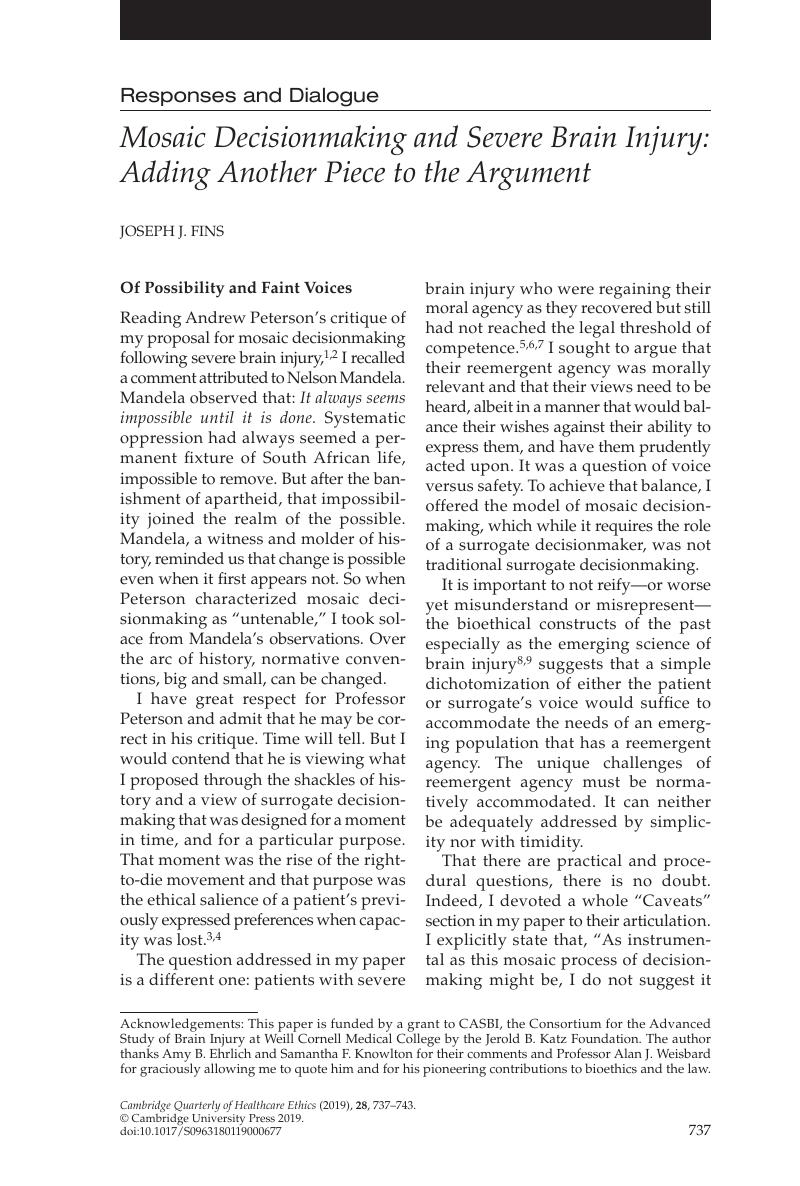Published online by Cambridge University Press: 19 August 2019

Acknowledgements: This paper is funded by a grant to CASBI, the Consortium for the Advanced Study of Brain Injury at Weill Cornell Medical College by the Jerold B. Katz Foundation. The author thanks Amy B. Ehrlich and Samantha F. Knowlton for their comments and Professor Alan J. Weisbard for graciously allowing me to quote him and for his pioneering contributions to bioethics and the law.
1. Fins, JJ. Mosaic decisionmaking and reemergent agency following severe brain injury. Cambridge Quarterly of Health Care Ethics 2018;27(1):163–74.CrossRefGoogle Scholar
2. Peterson, A. A critical analysis of Fins’s mosaic decisionmaking. Cambridge Quarterly of Healthcare Ethics 28(4). https://doi.org/10.1017/S0963180119000665.CrossRefGoogle Scholar
3. Jonsen, AR. The Birth of Bioethics. New York: Oxford University Press; 1998.Google Scholar
4. Fins, JJ. A Palliative Ethic of Care: Clinical Wisdom at Life’s End. Sudbury, MA: Jones and Bartlett; 2006.Google Scholar
5. Fins, JJ. Rights Come to Mind: Brain Injury, Ethics and the Struggle for Consciousness. New York: Cambridge University Press; 2015.CrossRefGoogle Scholar
6. Wright, MS, Ulrich, MR and Fins, JJ. Participating in research while under guardianship? Implications of current law and policy for research on persons with brain injuries and disorders of consciousness. Kennedy Institute of Ethics Journal 2017;27(1):43–70.CrossRefGoogle Scholar
7. Wright, MS, Kraft, C, Ulrich, MR, Fins, JJ. Capacity, competence, and the minimally conscious state: Lessons from a developmental model. American Journal of Bioethics-Neuroscience 2018;9:56–64.Google Scholar
8. Giacino, JT, Fins, JJ, Laureys, S, Schiff, ND. Disorders of consciousness after acquired brain injury: The state of the science. Nature Reviews Neurology 2014;10:99–114.CrossRefGoogle ScholarPubMed
9. Giacino, JT, Katz, DI, Schiff, ND, Whyte, J, Ashman, EJ, Ashwal, S, Barbano, R, Hammond, FM, Laureys, S, Ling, GSF, Nakase-Richardson, R, Seel, RT, Yablon, S, Getchius, TSD, Gronseth, GS, Armstrong, MJ. Practice guideline update recommendations summary: Disorders of consciousness: Report of the Guideline Development, Dissemination, and Implementation Subcommittee of the American Academy of Neurology; the American Congress of Rehabilitation Medicine; and the National Institute on Disability, Independent Living, and Rehabilitation Research. Neurology 2018;91(10):450–60.CrossRefGoogle ScholarPubMed Simultaneously published in: Archives of Physical Medicine and Rehabilitation 2018;99(9):1699–709.
10. See note 1, Fins 2018.
11. See note 2, Peterson 2019.
12. Miller, FG, Fins, JJ, Bacchetta, MD. Clinical pragmatism: John Dewey and clinical ethics. The Journal of Contemporary Health Law and Policy 1996;13(27):27–51.Google Scholar
13. Fins, JJ, Bacchetta, MD, Miller, FG. Clinical pragmatism: A method of moral problem solving. Kennedy Institute of Ethics Journal 1997;7(2):129–45.CrossRefGoogle ScholarPubMed
14. Fins, JJ. Clinical pragmatism and the care of brain injured patients: Towards a palliative neuroethics for disorders of consciousness. Progress in Brain Research 2005;150:565–82.CrossRefGoogle Scholar
15. Fins, JJ, Illes, J. Pragmatic convergence and the epistemology of an adolescent neuroethics. Introduction to a collection entitled, Competing Identities of Neuroethics. Cambridge Quarterly of Healthcare Ethics 2018;27(4):554–7.CrossRefGoogle Scholar
16. See note 2, Peterson 2019.
17. Moreno, JD. Deciding Together: Bioethics and Moral Consensus. New York: Oxford University Press; 1995.Google Scholar
18. See note 2, Peterson 2019.
19. See note 2, Peterson 2019.
20. Chatelle, C, Thibaut, A, Whyte, J, De Val, MD, Laureys, S, Schnakers, C. Pain issues in disorders of consciousness. Brain Injury 2014;28(9):1202–8.CrossRefGoogle ScholarPubMed
21. Fins, JJ, Bernat, JL. Ethical, palliative, and policy considerations in disorders of consciousness. Neurology 2018;91:471–5.CrossRefGoogle ScholarPubMed Simultaneously published in: Archives of Physical Medicine and Rehabilitation 2018;99(9):1927–31.
22. Fins, JJ. Neuroethics and disorders of consciousness: A pragmatic approach to neuro-palliative care. In, The Neurology of Consciousness, Cognitive Neuroscience and Neuropathology, 2nd ed. Laureys, S, Osseries, O, Tononi, G, eds. Amsterdam: Elsevier; 2015, at 241–55.Google Scholar
23. Fins, JJ, Pohl, BR. Neuro-palliative care and disorders of consciousness. In, Oxford Textbook of Palliative Medicine, 5th ed. Hanks, G, Cherny, NI, Christakis, NA, Fallon, M, Kassa, S, Portenoy, RK, eds. Oxford: Oxford University Press; 2015, at 285–91.Google Scholar
24. New York State Justice Center for the Protection of People with Special Needs. Surrogate Decision-Making Committee Program: Volunteer Panel Member Handbook. Surrogate Decisiodln-making Committee, January 2019; available at https://www.justicecenter.ny.gov/sites/default/files/documents/SDMC%20VPM%20Handbook%201.4.19_2.pdf (last accessed 14 May 2019).
25. Groopman, L, Miller, FG, Fins, JJ. The Patient’s Work. Cambridge Quarterly of Healthcare Ethics 2007;14:44–52.Google Scholar
26. Charlton, JI. Nothing About Us Without US. Berkeley: University of California Press; 2000.Google Scholar
27. See note 2, Peterson 2019.
28. Fins, JJ, Schiff, ND. Differences that make a difference in disorders of consciousness. American Journal of Bioethics-Neuroethics 2017;8(3):131–4.Google Scholar
29. Kandel, E. Reductionism in Art and Brain Science: Bridging the Two Cultures. New York: Columbia University Press; 2016.CrossRefGoogle Scholar
30. Snow, CP. The Two Cultures and The Scientific Revolution. New York: Cambridge University Press; 1959.Google Scholar
31. Fins, JJ, de Melo Martin, I. C.P. Snow’s Two Cultures fifty years later: An enduring problem with an elusive solution. Technology in Society 2010;32(1):1–4.CrossRefGoogle Scholar
32. See note 29, Kandel 2016.
33. Snow, CP. The Two Cultures and a Second Look. New York: Mentor; 1964.Google Scholar
34. Fins, JJ. C.P. Snow at Wesleyan: Liberal learning and the origins of the “Third Culture.” Technology in Society 2010;32(1):10–7.CrossRefGoogle Scholar
35. Kuhn, TS. The Structure of Scientific Revolutions, 2nd ed. Chicago: University of Chicago Press; 1970.Google Scholar
36. Katz, J. The Silent World of Doctor and Patient. New York: The Free Press; 1984.Google Scholar
37. Weisbard AJ. MCW Bioethics Discussion Forum. 9/19/18. Quoted with permission of Professor Weisbard.
38. See note 37, Weisbard 2018.
39. See note 37, Weisbard 2018.